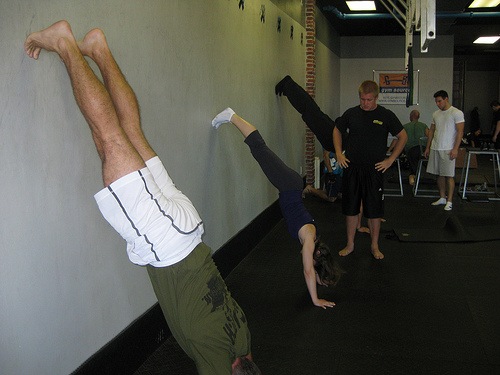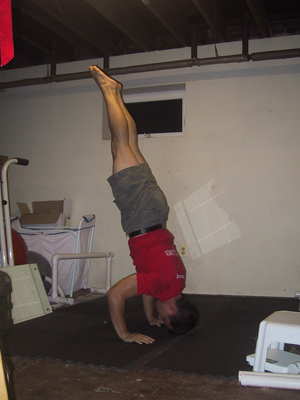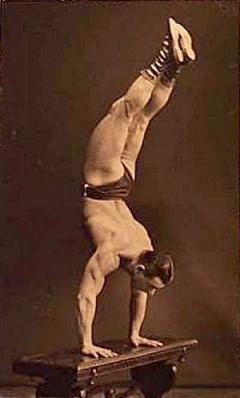My comments on the Gymnastic WOD handstand videos
By Jim Bathurst, BeastSkills.com
A visitor to my site recently brought to my attention the Gymnastic WOD videos, created by Carl Paoli, regarding handstand progressions against the wall (embedded videos below). These videos were of particular interest because the progressions taught were different than the ones I teach athletes. In some cases, the progressions were so completely contradictory to the progressions that I currently teach, that I felt an overwhelming need to comment.
So here I am writing this article to discuss the various techniques and progressions for the handstand. This article is not an attack. I offer only the utmost respect to Carl. His bio states that he was an elite gymnast in Spain for over fifteen years. He clearly has expertise on this subject.
I, on the other hand, learned a handstand about 13 years ago in my backyard, basement, and bedroom. I was not given any sort of professional guidance until half-way through college in a recreational Gymnastics club (Gymkana). At this point, I had already taught myself a handstand and freestanding handstand pushups. Mine has often been a slow and labored journey though gymnastics without this professional guidance, but I feel that I have learned a lot.
Over the past several years, I have been asked to give seminars to numerous CrossFit gyms on gymnastic skills such as the handstand, handstand pushups, and the muscle-up. I have learned a lot from this as well, as I have encountered problems with people’s technique that I have had to solve.
I still have a lot to learn. I’ve made and still make a lot of mistakes. I also want to note that the tutorials on BeastSkills.com, while helpful, sometimes reflect my thinking from 5 years ago. I haven’t always radically changed my thinking, but I am constantly adapting and tweaking my progressions and ideas. It’s at the seminars that I give my most current thoughts on training the skills.
It’s also here that I present my current ideas and analysis of various handstand progressive techniques, as they are discussed in the Gymnastic WOD video. Please keep in mind that I may simply be an amateur that has missed the point entirely. I could be wrong. Maybe it’s a terrible tragedy, but I hope you find this article thought-provoking.
Handstand against the wall progression pt. 1
Carl starts off the video by explaining that a handstand with your chest against the wall is better than a handstand with your back against the wall. I prefer teaching a “back against the wall” method. In regards to a handstand with your back against the wall, he states –
0:26 “it doesn’t translate into more things down the line”
and
0:33 “we want to make sure that we’re always doing progressive skills that have more options, and we never hit that ceiling”
I’ll start off by asking “What are we training for? What are these skills that will be limited by using the back to the wall handstand?”
If one was to look at high level gymnastics, then I would argue that only using an extended or “arched” handstand position, as might first be developed when one’s back is to the wall, would hamper rotational skills – those needed for parallel bar, high bar, vault, and floor skills. An arched handstand won’t rotate nearly as well as a straight-lined, hollow body handstand. But do we – recreational athletes – need to emphasize that?
You may also see pictures of handstands from years past. What do you see? You see arched and extended handstands. Is this considered a lesser handstand?
Sig Klein
I believe that the biggest struggle for people holding a handstand isn’t lack of a perfectly straight body position, it’s just finding the balance! One can find the balance and control in a handstand perfectly well, and safer, in a handstand with their back facing the wall. Straightening up the handstand after balance is gained, in my experience, is not as difficult as just working the balance!
Some may argue it adds another step – having to “clean up” the handstand – but I would say that people get too wrapped up in theory and forget the practical. We want to balance on our hands. I’ve seen numerous people over the years that have excellent form in their handstand, but can’t hold it at all! We’re detailing a car that has no engine!
At 2:08, Carl shows that a back to the wall handstand can result in your shoulders dropping forward and the ribcage coming out. I’d agree. This can definitely happen when you kick up with your back to wall. I would argue that a position as he shows can be a result from lack of strength and mobility, not an inevitability of the ‘back to the wall’ teaching style. We don’t remain in that position against the wall, but tap our feet away and stretch ourselves out to a straighter handstand position.
What then would I do with an athlete who is collapsing and arching severely, as Carl shows, and unable to change their position? I’d have a client practice holding a stretched body position with their stomach to the wall (hands a couple feet from the wall) to build strength, I’d have them work on their shoulder mobility and flexibility (as seen in the video below), but still have them practice finding their balance with their back to the wall.
Walking up the wall progression
I completely agree with this exercise. It’s great. It builds strength in the shoulders and teaches people to push hard, get tight, and get their body in line. It’s a great exercise for beginners, as it also gives them the confidence that they can actually hold their bodyweight up on their arms. It also teaches the hollow position. I use it in my seminars all the time.

Beast Skills seminar participants. That’s about as far as I have them walk into the wall.
I disagree with bringing the hands all the way into the wall though, as he states –
1:00 “We’re going to go as close as we can possibly get to the wall”
We get into precarious positions when we get close to the wall with the stomach facing it. How do we get out of the position safely when we fatigue or over-balance (fall to our backside)? Carl recommends forward rolling out of the position, which I’ll later elaborate on several reasons why I don’t prefer that. With beginners that I have coached, I can only see them crashing onto the heads or backs if they get into trouble. With the back to the wall, athletes have a better chance of simply kicking off the wall and falling back down to their feet. It’s safer.
Carl continues that the stomach against the wall is scalable –
2:30 “chest against the wall will definitely give you that better positioning from the beginning, and you can actually scale it at different levels…”
I didn’t understand this point. When your stomach is facing the wall, and you move your hands in closer (more closely representing the handstand position), it becomes easier to hold, whereas if you move your hands away from the wall, it becomes harder to hold that position. Again, I think it’s an excellent exercise to build shoulder strength and body control for the handstand, but I was confused on this point.
I’ll also use this opportunity to make a note of putting your head between your arms and looking off in the distance, instead of looking toward the ground, as Carl demonstrates. Will tucking your head make it easier to get your body in a straight line? Absolutely, the spine follows the head. But this only works if you have the shoulder flexibility. Teaching this technique across the board can be dangerous.
What do you get when someone with less than adequate shoulder flexibility tucks their head and kicks up into a handstand? You get the shoulders coming forward of the balance point and the athlete inadvertently kicks themselves into a forward roll. If this was inadvertent, you better believe they aren’t coming down pretty. I’ve seen enough athletes crash down as they tried to bring their head in. Therefore, I teach to look down at the ground and your hands at first. It may close off the shoulders a bit and arch their handstand, but it may be the handstand position you work with until you open up your shoulders more.
This is the difference between what might be an optimal position, and what is an actual safe and useable position. To put it another way, you wouldn’t have someone with poor hip mobility squat all the way to the ground, would you?
Handstand Against Wall Progression Pt.2
Carl starts the next video with talks about how to get away from the wall and find the balance in the handstand, as well as what to do to bail out of it. He shows that when you’re up in a handstand with your stomach facing the wall, you start to tap your feet away from the wall to find the balance. He states –
“the good thing about this is that there are only two options. One – if you can’t make it you’ll fall back to the wall, or two – you’ll have to do a forward roll out of that handstand.”
I’ll argue that there is a third option – coming down on your back or head.
Why I don’t like forward rolls as a bailout, and haven’t done one in a decade.
1. Many can’t even do a forward roll, at least not with as much confidence and fluidity that is shown. So do beginners have to learn a new skill to work on the handstand?
2. Now let’s assume we can do a perfect forward roll. Are we always practicing on gymnastic mats? I rarely had one, and it doesn’t feel good to roll on hard ground.
3. Are we always practicing with enough space to roll? In my bedroom I had to avoid hitting my dresser and nightstand.
4. Let’s assume we can do a perfect forward roll, and have a gymnastics mat, and have enough space to roll – have you ever done a bunch of forward rolls? Did it make you sick? Getting the handstand is going to take countless nauseating tries.
Carl then states –
1:50 “You can even go into a cartwheel, but usually cartwheels means that there’s some kind of imbalance going on”
I completely disagree with this point. What imbalance? I cartwheel out of my handstand because it keeps my head and shoulders off the floor, prevents me from feeling nauseated, and puts my feet on the floor to practice the handstand again. How do you think a gymnast on a set of parallel bars comes out of an overbalanced handstand? A forward roll? Or a cartwheel/pirouette off the bars?
I do like the technique of keeping one foot on the wall, and moving one foot off the wall. I currently teach the technique to tap both feet off the wall at the same time and stretch them up to the sky (which straightens out the body fairly well). The technique of keeping one foot on the wall, and moving one foot off the wall, as Carl shows, lets someone slowly ease into the balance of the handstand – whether they are stomach facing or back facing. Again, I like it and will test it with my athletes.
Handstand Pushup up against the wall
This last note is in regards to the handstand pushup up against the wall video.
I think this is a great technique for handstand pushups. I think this would also be very helpful for those looking to get a freestanding handstand pushup – it puts everything where it needs to be – elbows in, and the body at the slight angle that it needs to be for balancing in the freestanding handstand pushup.

From freestanding handstand pushup tutorial
I just wanted to share a realization that I had over the past several years of teaching the skill. We all need to start working full range handstand pushup variations as soon as possible. This means putting your hands up on small boxes or parallettes and going until your hands reach the top of your shoulders. We don’t half rep squats on a regular basis, yet the handstand pushup is essentially half-repped everytime we only work it on the floor.
Now many won’t be able to do the full range handstand pushup against the wall. In this case, we scale back the exercise and put the athlete’s feet up on boxes and their body into a pike position (bent 90 degrees at the waist). I’ve been mentioning to gyms to incorporate this into their gymnastic training.
If you train full range, you may not get as good a “score” on your WOD, but I can guarantee that you’ll get stronger and demolish “regular” handstand pushups.
Thanks for reading. I hope this article raises some thoughts in your training. Let me know what you think! Leave a comment!



This may be a very late reply, but how does a “stretched body position, with stomach against the wall” look like, and how is it different from the stomach against the wall approach that coach Carl advocates?
Also, would this be a good progression for someone hoping to build up to free standing handstands? I modified it a bit after reading your take on coach Carl’s HS progression.
1. Hold a strict hollow body position on the floor for at least 30 seconds.
2. Walk up the wall. Work up to ‘x’ reps? (maybe 5-10 reps?)
3. Lunge-to-handstand with back against wall, feet planted on wall. Work up to at least a 30 second hold.
4. Lunge-to-handstand with back against wall, feet away from wall. Work up to at least a minute hold.
4. Free standing handstands
Also, would doing pike push-ups be a good starting place for developing hand stand push-ups?